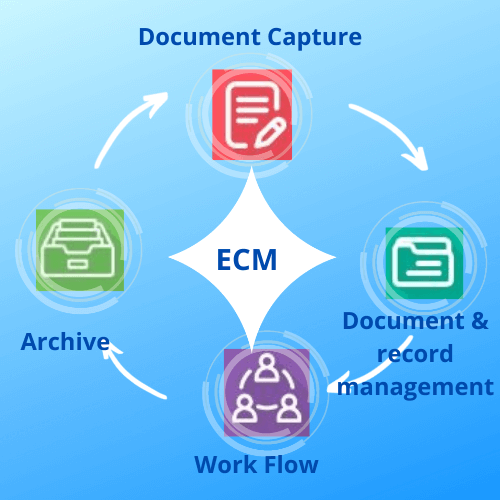Enterprise Content Management
Enterprise Content Management (ECM) Systems enable enterprises save time and money by efficiently managing documents and information. By digitizing paper documents and automating document-driven processes, the right people get access to the correct information at the right time, simply and securely.
Our Expertise

Development
We have proven expertise and resources in developing the business flow based on the client requirements.

Upgradation

Support
We do 24X7 application support based on client requirements for define Service Level Read More

Enhancement
Our resources help enhance existing applications for better experience and implementing Read More
global accounts.
ECM workflow
Document Capture:
The process of importing all your information into a digital repository.
Secure Document Storage
Easily store business-critical documents Read More
Full-Text Search & Retrieval
Instantly find documents by identifying specificRead More
Collaboration
What happens when teams have access to the information they need? They work together better and more work Read More
Automation of Business Processes
The steps of a business process Read More
Granular Document Security
Take control of information across Read More
Digitally Capture, Route, and Approve Forms
Replace paper forms with electronic forms to captureRead More
Compliance
Are you always focused on privacy, like HIPAA or FACTA or information management like SOX? ECM systems have the controls Read More
.
Key Industry domains supported









The Document Life cycle
- Create: Companies “CREATE” a lot of data
- Customer Data
- Utilization Data
- Other Private, Confidential, Proprietary Data
- Maintain: Companies “MAINTAIN” the created Data
- Own Servers
- Variety of Cloud
- Employee laptop, Computers, Edge devices
- Destruct: Is there adequate attention given to “DESTRUCTION”
- What is at stake if “DATA BREACH” happens
- What are the regulatory, compliance requirement
- The magnitude of Reputational and Financial Loss.

Frequently Asked Questions
Enterprise Content Management (ECM) Systems enable enterprises save time and money by efficiently managing documents and information. By digitizing paper documents and automating documentdriven processes, the right people get access to the correct information at the right time, simply and securely.
- Document Capture – The process of importing all your information into a digital repository.
- Secure Document Storage – Easily store business-critical documents in a digital repository,
and instantly view or make edits to them. - Full-Text Search & Retrieval – Instantly find documents by identifying specific words or
phrases within their text, metadata, annotations, and entry names. - Collaboration – What happens when teams have access to the information they need? They
work together better and more work gets completed. Built-in collaboration tools let people
edit, update, and approve versions as they go, no more exchanging emails and waiting for
approvals. - Automation of Business Processes – The steps of a business process can be easily
represented diagrammatically and automatically route documents to the right people at the
right time. - Granular Document Security – Take control of information across the enterprise by restricting
access to folders, documents, electronic files, fields, annotations, and other granular
document properties. - Digitally Capture, Route, and Approve Forms – Replace paper forms with electronic forms to
capture information and share it across the enterprise digitally. - Compliance – Are you always focused on privacy, like HIPAA or FACTA or information
management like SOX? ECM systems have the controls you need and deliver reports that
make audits a breeze.
- Content, information, and document centralization.
- Increased productivity.
- Enhanced accessibility.
- Boosted collaboration.
- Reduced organizational risk.
- Added eco-friendliness.
- Better business processes